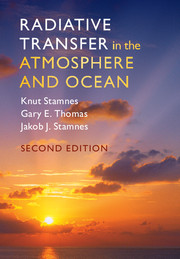Book contents
- Frontmatter
- Contents
- List of Illustrations
- List of Tables
- 1 Basic Properties of Radiation, Atmospheres, and Oceans
- 2 Basic State Variables and the Radiative Transfer Equation
- 3 Basic Scattering Processes
- 4 Absorption by Solid, Aqueous, and Gaseous Media
- 5 Principles of Radiative Transfer
- 6 Formulation of Radiative Transfer Problems
- 7 Approximate Solutions of Prototype Problems
- 8 The Role of Radiation in Climate
- 9 Accurate Numerical Solutions of Prototype Problems
- 10 Shortwave Radiative Transfer in the Atmosphere and Ocean
- Appendix A Nomenclature: Glossary of Symbols
- Appendix B Physical Constants
- Appendix C Ocean Optics Nomenclature
- Appendix D Reflectance and Transmittance at an Interface
- References
- Index
7 - Approximate Solutions of Prototype Problems
Published online by Cambridge University Press: 13 July 2017
- Frontmatter
- Contents
- List of Illustrations
- List of Tables
- 1 Basic Properties of Radiation, Atmospheres, and Oceans
- 2 Basic State Variables and the Radiative Transfer Equation
- 3 Basic Scattering Processes
- 4 Absorption by Solid, Aqueous, and Gaseous Media
- 5 Principles of Radiative Transfer
- 6 Formulation of Radiative Transfer Problems
- 7 Approximate Solutions of Prototype Problems
- 8 The Role of Radiation in Climate
- 9 Accurate Numerical Solutions of Prototype Problems
- 10 Shortwave Radiative Transfer in the Atmosphere and Ocean
- Appendix A Nomenclature: Glossary of Symbols
- Appendix B Physical Constants
- Appendix C Ocean Optics Nomenclature
- Appendix D Reflectance and Transmittance at an Interface
- References
- Index
Summary
Introduction
We now describe several approximate methods of solution of the radiative transfer equation. Approximate methods play an important role in the subject, since they usually provide more insight than the more accurate methods: indeed, their simple mathematical forms help clarify physical aspects that are not easily discerned from the numerical output of a computer code. Another redeeming feature of approximate methods is that they are often sufficiently accurate that no further effort is necessary. Unlike some of the more sophisticated numerical techniques, these methods also yield approximations for the internal radiation field, including the source function. Of central importance is the two-stream approximation. This class of solutions has been given various names in the past (Schuster–Schwarzschild, Eddington, two-stream, diffusion approximation, two-flow analysis, etc.). In all variations of the method, the intractable integro-differential equation of radiative transfer is replaced with representations of the angular dependence of the radiation field in terms of just two functions of optical depth. These two functions obey two linear, coupled, ordinary differential equations.When the medium is homogeneous, the coefficients of these equations are constants, and analytic closed-form solutions are possible. The mathematical forms of these solutions are exponentials in optical depth, depending on the total optical depth of the medium, the single-scattering albedo, one or two moments of the scattering phase function, and the boundary radiances. Some disadvantages are that two-stream solutions maintain acceptable accuracy over a rather restricted range of the parameters; there is no useful a priori method to estimate the accuracy; and one generally needs an accurate solution to obtain a useful estimate of the accuracy.
Two-stream methods have been applied to multi-layer problems, and to the computation of photolysis and heating rates in the presence of scattering. Although computationally intensive radiative transfer schemes are capable of accuracy better than 1%, it is unlikely that the inputs to the models are nearly this accurate.
In the present era of fast computers, there is still a need for fast computational radiation algorithms (such as the two-stream method), particularly in threedimensional photochemical/dynamical models. For example, the Community Climate System Model CCSM4 uses an algorithm for shortwave radiative transfer computations based on a two-stream (Eddington) method (Gent et al., 2011).
- Type
- Chapter
- Information
- Radiative Transfer in the Atmosphere and Ocean , pp. 227 - 277Publisher: Cambridge University PressPrint publication year: 2017



